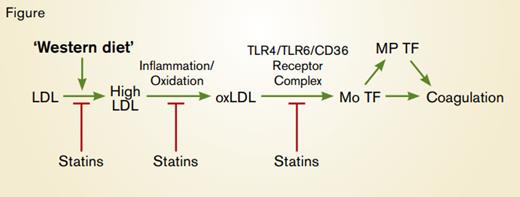"Pathway Linking Hypercholesterolemia to Activation of Coagulation. A western diet increases LDL levels some of which is converted to oxidized LDL
"Pathway Linking Hypercholesterolemia to Activation of Coagulation. A western diet increases LDL levels some of which is converted to oxidized LDL
The late Russell Ross championed the concept that atherosclerosis is an inflammatory disease that does not occur simply due to the accumulation of lipids in the vessel wall, as 50 percent of patients with cardiovascular disease have normal cholesterol levels. According to this response-to-injury hypothesis, modified lipids, endothelial dysfunction,monocytes, lymphocytes, platelets, cytokines, and procoagulant factors all conspire to mediate the atherogenic process. In 1999, Dr. Ross suggested that selective modification of the harmful effects of inflammation would be an effective strategy for ameliorating cardiovascular disease.1 The success of statin therapy validates the prescient insights of Dr. Ross, as these drugs not only lower cholesterol but also have both anti-inflammatory and anti-thrombotic properties (Figure). In a sentinel study, Owens et al. in the laboratory of Dr. Nigel Mackman at the University of North Carolina provide additional compelling evidence in support of Dr. Ross’ hypothesis by showing that inhibiting monocyte tissue factor (TF)-dependent activation in mice and monkeys with simvastatin alters the course of cardiovascular disease.
The investigators hypothesized that hypercholesterolemia leads to elevated levels of oxidized LDL (oxLDL) in plasma and that this bioactive product induces the expression of procoagulant TF in monocytes. In support of this hypothesis, patients with familial hypercholesterolemia were shown to have elevated levels of plasma microparticle (MP) with TF activity. In vitro, oxLDL induced TF expression in human monocytic cells, and this effect was attenuated by the administration of simvastatin. In addition, Owens and colleagues demonstrated that, in LDL receptor-deficient mice, a high-fat diet induced a time-dependent increase in both plasma MP TF activity and activation of coagulation and that these effects were blocked by statin therapy. That monocyte-derived TF is responsible for the activation of coagulation was further supported by experiments demonstrating that hypercholesterolemic mice transplanted with bone marrow genetically deficient in TF were not hypercoagulable. The mechanism for oxLDL-induced TF is likely due to oxLDL binding to the heterotrimeric complex CD36/TLR4/TLR6 in monocytes.2 (Figure). Thus, as anticipated, deficiency of either TLR4 or TLR6 reduced levels of MP TF activity in hypercholesterolemic mice. Further, simvastatin treatment of African green monkeys fed a high-fat diet reduced oxLDL, monocyte TF expression, MP TF activity, activation of coagulation, and inflammation without affecting total cholesterol levels.
In Brief
MP delivery of TF to sites of plaque rupture appears to be of paramount importance in the pathophysiology of deadly coronary thrombosis, so as predicted by Dr. Ross, selectively decreasing inflammation is heart-healthy. The studies of Owens and colleagues demonstrate the interplay between oxidation of LDL, activation of the innate immune system, and formation of onocytederived TF MPs (Figure), suggesting that interrupting TF and/or MP formation or inhibiting the CD36/TLR4/TLR6 receptor would be reasonable strategies for ameliorating cardiovascular disease. While developing new drugs that regulate these processes poses important pharmacologic challenges (e.g., bleeding in the case of TF inhibitors or complications of decreased host defense in the case of blocking the innate immune system), identifying safe, cost-effective approaches to treating or preventing a disease that affects the health of hundreds of millions worldwide is an urgent need, and an understanding of the underlying pathobiology of the disease process is an essential step toward achieving this lofty goal.
References
Competing Interests
Dr. Vercellotti indicated no relevant conflicts of interest.

